
The City of Kwinana is a local government area of Western Australia. It covers an area of approximately 118 square kilometres in metropolitan Perth, and lies about 38 km south of the Perth central business district, via the Kwinana Freeway. Kwinana maintains 287 km of roads and had a population of almost 39,000 as at the 2016 Census.
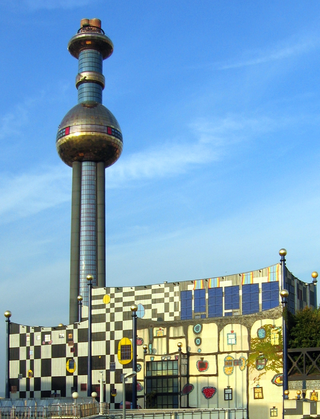
Waste-to-energy (WtE) or energy-from-waste (EfW) is the process of generating energy in the form of electricity and/or heat from the primary treatment of waste, or the processing of waste into a fuel source. WtE is a form of energy recovery. Most WtE processes generate electricity and/or heat directly through combustion, or produce a combustible fuel commodity, such as methane, methanol, ethanol or synthetic fuels, often derived from the product syngas.

Wind power, a form of renewable energy harnessed through wind turbines, stands as a pivotal contributor to Australia's energy landscape. With a total installed wind capacity reaching approximately 9,100 megawatts (MW), as of October 2023, wind power constitutes a significant portion, representing 5% of Australia's total primary energy supply and a substantial 35% of its renewable energy supply. Australia's geographic disposition favors the proliferation of wind energy infrastructure, particularly in the southern regions of the nation and along the slopes of the Great Dividing Range in the east. Approximately half of Australia's wind farms are located near coastal regions.

Solar power is a major contributor to electricity supply in Australia. As of December 2023, Australia's over 3.69 million solar PV installations had a combined capacity of 34.2 GW photovoltaic (PV) solar power. In 2019, 59 solar PV projects with a combined capacity of 2,881 MW were either under construction, constructed or due to start construction having reached financial closure. Solar accounted for 12.4% of Australia's total electrical energy production in 2021.

The energy policy of Australia is subject to the regulatory and fiscal influence of all three levels of government in Australia, although only the State and Federal levels determine policy for primary industries such as coal. Federal policies for energy in Australia continue to support the coal mining and natural gas industries through subsidies for fossil fuel use and production. Australia is the 10th most coal-dependent country in the world. Coal and natural gas, along with oil-based products, are currently the primary sources of Australian energy usage and the coal industry produces over 30% of Australia's total greenhouse gas emissions. In 2018 Australia was the 8th highest emitter of greenhouse gases per capita in the world.

Renewable energy in Australia is mainly based on biomass, solar, wind, and hydro generation. Over a third of electricity is generated from renewables, and is increasing, with a target to phase out coal power before 2040. Wind energy and rooftop solar have particularly grown since 2010. The growth has been stimulated by government energy policy in order to limit the rate of climate change in Australia that has been brought about by the use of fossil fuels. Pros and cons of various types of renewable energy are being investigated, and more recently there have been trials of green hydrogen and wave power.

Teesside Energy from Waste plant is a municipal waste incinerator and waste-to-energy power station, which provides 29.2 megawatts (MW) of electricity for the National Grid by burning 390,000 tonnes of household and commercial waste a year. It is located on the River Tees at Haverton Hill, east of Billingham in North East England. Developed and built by NEM, a subsidiary of Northumbrian Water, the initial plant replaced the Portrack Incinerator and opened in 1998. Subsequently, the facility became part of SITA, now Suez.

Australia is the driest habitable continent on Earth and its installed desalination capacity has been increasing. Until a few decades ago, Australia met its demands for water by drawing freshwater from dams and water catchments. As a result of the water supply crisis during the severe 1997–2009 drought, state governments began building desalination plants that purify seawater using reverse osmosis technology. Approximately one percent of the world's drinkable water originates from desalination plants.
Kwinana Cogeneration Plant was a cogeneration facility located 40 kilometres (25 mi) south of Perth, Western Australia that operated from 1994 to 2022. It provided steam and electrical power to the BP Australia Kwinana Oil Refinery and electricity to Synergy, the State owned generator/retailer.

Cleanaway Waste Management Limited is an Australian waste management company. Founded in 1979 by Brambles, it has extensive operations in Australia and the United Kingdom.
Plasma gasification is in commercial use as a waste-to-energy system that converts municipal solid waste, tires, hazardous waste, and sewage sludge into synthesis gas (syngas) containing hydrogen and carbon monoxide that can be used to generate power. Municipal-scale waste disposal plasma arc facilities have been in operation in Japan and China since 2002. No commercial implementations in Europe and North America have succeeded so far. The technology is characterized by the potential of very high level of destruction of the incoming waste, but low or negative net energy production and high operational costs.
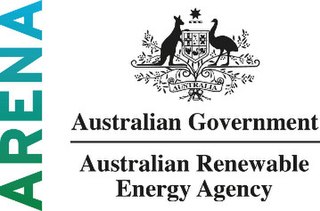
The Australian Renewable Energy Agency (ARENA) is an independent agency of the Australian federal government, established in 2012 to manage Australia's renewable energy programs, with the objective of increasing supply and competitiveness of Australian renewable energy sources.
Sundrop Farms is a developer, owner and operator of high tech greenhouse facilities which grow crops using methods which reduce reliance on finite natural resources when compared to conventional greenhouse production. Sundrop Farms opened its first pilot facility in Port Augusta, South Australia, in 2010. This facility was originally designed as a Seawater Greenhouse. However, significant technology changes led to the Sundrop System, and the dissolution of the joint venture with Seawater Greenhouse Ltd. Sundrop Farms commissioned an expanded 20 ha facility south of Port Augusta in 2016. Sundrop Farms has offices in London, UK and Adelaide, Australia. In October 2016, Sundrop Farms was operating greenhouses in Portugal, the United States and had another facility planned in Australia.
There is enormous potential for renewable energy in Kazakhstan, particularly from wind and small hydropower plants. The Republic of Kazakhstan has the potential to generate 10 times as much power as it currently needs from wind energy alone. But renewable energy accounts for just 0.6 percent of all power installations. Of that, 95 percent comes from small hydropower projects. The main barriers to investment in renewable energy are relatively high financing costs and an absence of uniform feed-in tariffs for electricity from renewable sources. The amount and duration of renewable energy feed-in tariffs are separately evaluated for each project, based on feasibility studies and project-specific generation costs. Power from wind, solar, biomass and water up to 35 MW, plus geothermal sources, are eligible for the tariff and transmission companies are required to purchase the energy of renewable energy producers. An amendment that introduces and clarifies technology-specific tariffs is now being prepared. It is expected to be adopted by Parliament by the end of 2014. In addition, the World Bank's Ease of Doing Business indicator shows the country to be relatively investor-friendly, ranking it in 10th position for investor protection.

The Virginia City Hybrid Energy Center (VCHEC) is a power station located in St. Paul, in Wise County, Virginia. It is operated by Dominion Virginia Power, Dominion Resources Inc.'s electric distribution company in Virginia. The 600 MW plant began power generation in July 2012 after four years of construction. The plant deploys circulating fluidized bed boiler technology (CFB) to use a variety of fuel sources including bituminous coal, coal gob, and bio-fuels. VCHEC is placed under stringent environmental regulations by the Virginia Department of Environmental Quality (DEQ).

The Murra Warra Wind Farm is one of Australia's largest wind farms. Located on the plains of north-western Victoria, approximately 25 kilometres (16 mi) north of the city of Horsham, it consists of 99 wind turbines with a maximum tip height of 220m.
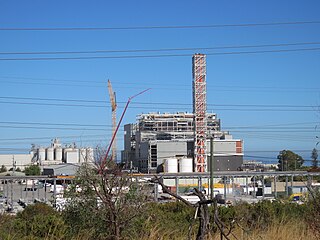
The Kwinana Waste to Energy Plant is a waste-to-energy power station under construction in Kwinana Beach, Western Australia. Once completed, the facility is scheduled to process in excess of 400,000 tonnes of waste and will produce 36 MW of power. Initially scheduled to open in 2021, delays pushed the projected date out to late 2024.
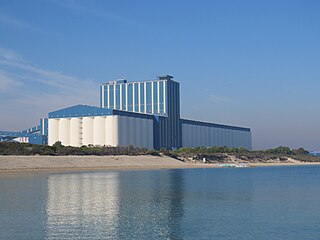
The Kwinana Grain Terminal is a grain terminal in East Rockingham, Western Australia. Built from 1969 onwards and operated by the CBH Group, the facility consists of a jetty, two horizontal storages, three silos, and four open bulk heads. Grain is transported to the site by rail, stored, and eventually loaded onto ships for export.
Pomona Waste To Energy Power Station, also Harare Solid Waste Plant, is a 22 MW (30,000 hp) solid waste-fired thermal power plant under development in Zimbabwe. The Harare City Council has awarded Geogenix BV, a Dutch waste management company, the concession contract to design, finance, construct, operate, maintain and own the power station for thirty years after commercial commissioning. As raw material, the power station is designed to use solid waste gathered from homes, businesses and industries in the city of Harare, the country's national capital. A 30-year power purchase agreement (PPA) has been signed between the developers of the power station and Zimbabwe Electricity Supply Authority (ZESA).
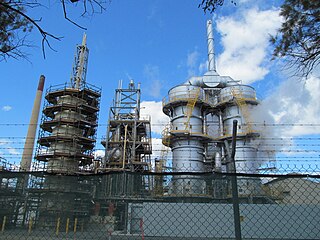
The Kwinana Nickel Refinery is a nickel refinery in East Rockingham and Kwinana Beach, Western Australia. The refinery is operated by BHP and part of its Nickel West operations. Having originally been built by WMC Resources, it changed ownership in 2005 when BHP acquired WMC.
















